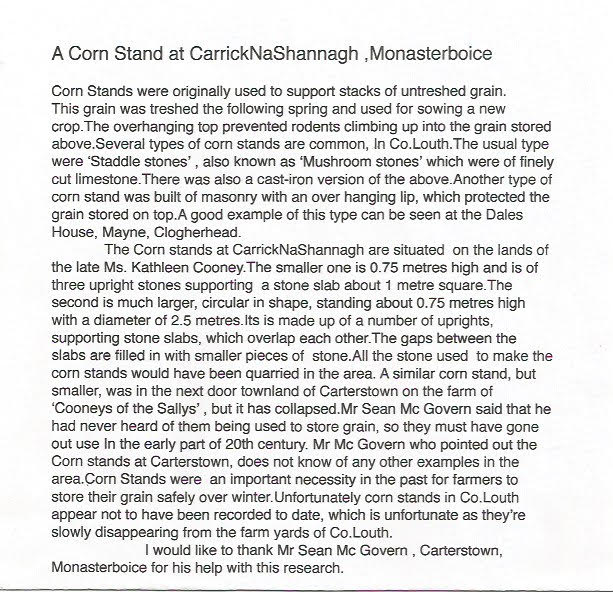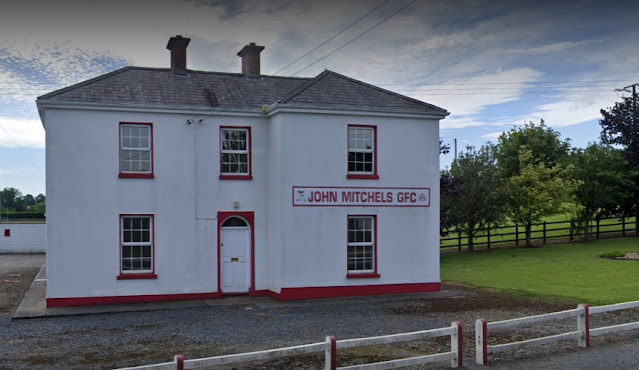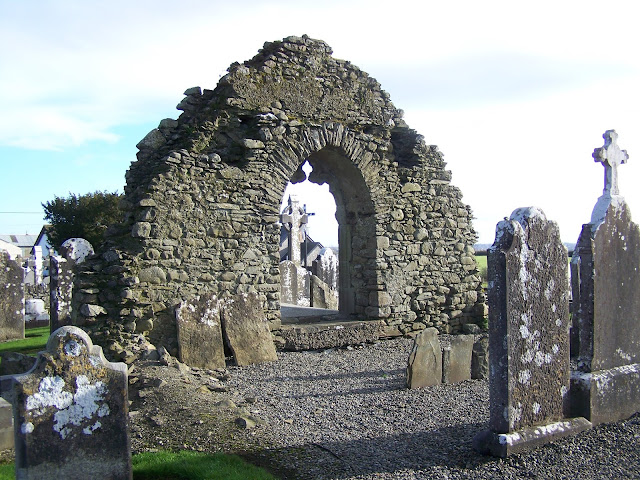Here are the answers to our Christmas Bumper edition of Where in the County.
A good number of the photographs are courtesy of Luke Torris, Kieran Campbell, Conor Kenny and Don Johnston. Without their generosity this would not have been possible and we thank them again.
Also many thanks to Bryan Rogers for some help with the text to some of the answers.
We also thank and acknowledge the following for photos: site 7 by Paul Gosling, site 27 by Jack Montgomery. site 29 by Adrian Cawley and site 31 by Owen McCann in the Louth Field Names Book edited by Eve Campbell.
Site 1
The article by Paul Gosling and Brendan
Peppar, in the 2020 Riocht na Midhe, about the memorial at Cusack's Cross examines the one in the photo. They record three
inscriptions on the front face as 'G:C.'; 'C.C.A.F.C.M' and '162[4]'. Tradition
holds that Captain Cusack stopped on his way to Ardee to water his horse and
was shot. The authors examine various sixteenth-century local Cusack families
to which Captain Cusack may have belonged.
Piedmont House, now a lonely
roofless ruin, was once an imposing slated building with a panoramic view of
Dundalk Bay to the south. It is a rare and important example of the
earliest unfortified mansion in north
Louth. With a severe central doorway framed by a stone moulding, the two-storey
late seventeenth-century structure is a plain rectangular block of roughly
coursed rubble masonry with some brick.
Being unsuccessful in Dunleer in 1715, Blayney Townley was eventually returned for Carlingford and continued as MP until his death at Piedmont in 1722. ‘Loved and esteemed while he lived and lamented when he died’, ‘he was buried in the Chancel of Dunleer by (i.e. beside) his wife Lucy’.
Their seven children were born in
Piedmont. Blayney, their youngest child, was born in 1705 and was baptised at
Ballymaconnolly. Blayney married his cousin, Mary, daughter of Hamilton Townley,
in 1734. They settled at Townley Hall, which she inherited from her father.
Taken from
Don Johnston's article
The 2018 Journal article by Paul Gosling is entitled: Cloghafarmore alias Cúchulainn’s Stone, Co. Louth: its topographic setting
The townland of Rathiddy is host to an
impressive prehistoric Standing Stone: a stout, slanted pillar of roc
The Standing Stone is widely referenced in
academic publications, well flagged in travel guides, endlessly pictured on the
web and eagerly promoted by tourism bodies. These present a limited menu of
significance focusing on the stone’s height and/or its role in the demise of
Cúchulainn. The more archaeological avoid all reference to the legends as if in
fear of being tainted, the more promotional announce it as a must-see
attraction and the most discerning recognize the tension between the two names.
Site 10
Gate lodge at Carstown Manor, Sandpit, Termonfeckin
Siena Convent at the Twenties, Drogheda.
https://miesarch.com/work/2073
McGettigan, archbishop of Armagh, consecrated the chapel on 10 June 1877 (Forristal 1999, 43-4). The chapel and convent were converted into apartments after the convent was sold.
Site 20
The Early Christian monastery of Inishmotte located on a former island (Frank Mitchell)
Site 30
Remains of the wreck of the three masted Barque “The Empire of Peace”
that sand in 1881, 1.5 miles off the coast at Annagassan.
Using the field books at the Valuation Office in Dublin, Seamus Keenan listed as owner in 1983 and before him, his father Patrick Keenan in 1958. Before that it was owned by the Rice family. Mrs Agnes Rice was listed as owner in 1937, she was daughter of Peter Bellew & of his wife Bridget (also née Bellew). Peter Bellew listed as owner in 1921. Patrick Bellew was listed as owner in 1917 [likely a brother of Peter]. Agnes Bellew married Peter, son of Thomas Rice of Bellurgan. The 1911 census, has Patrick Bellew was listed as Grocer and Spirit Merchent but he lived in Ballaverty near Rathcor, a few miles from Bellurgan, just across for the Church of Ireland (Bush/Rathcor).
In the 1901 Census, Catherine Boyle was
listed as a Publican in Bellurgan. In 1864 Owen Boyle was listed as owner of
the property. These Bellews originated in Kiltybane near Crossmaglen. Peter
Bellew also owned a pub at Kilcurry.
Medieval Harbour, Clogherhead known locally as Matthews’ Harbour or in
the 19th Century, as St. Denis’s Harbour.
In the statute rolls of 1475/1476 in the reign of Edward IV, a law was passed to support the repair of this harbour.
Sir Roland
Fitzeustace & Dame Margaret Jenico, his wife, intend to repair the northern
port of Kilclogher, through the non repair of which ships, boats, men &
goods were lost. From ancient times customs were granted to the lords of the
port for its construction & repair, but of late some persons had refused to
pay said customs. By an act of 1476 every boat coming into the port has to pay
4d, every ship having a boat 8d, & every boat fishing for herrings a mease
of herrings, to Roland & Margaret, provided there be no injury to the
inhabitants of Dublin or Drogheda. No boat going to the herring fishery was to
pay said mease save once yearly.
Thanks again to Bryan Rogers for help with this.
John
Finnegan m. Mary Kearney
though there seems to be contradiction on these.
for example:
Source:https://www.thejournal.ie/joe-bidens-irish-roots-2836388-Jun2016/
Taking the Kearney relationship into account (the family of the Irish Rugby players):
It would appear that
Mary Kearney m. John Finnegan was sister of the Kearney's paternal ancestor
Owen Finnegan a 1st cousin
James Finnegan a 2nd cousin
Ambrose Finnegan a 3rd cousin
Eugenia Finnegan-Biden a 4th cousin
Joe Biden a 5th cousin of David Kearney, father of the brothers Rob & Dave.
This was corroborated by a relative who taught in Dundalk and had the recall.
other sources:
http://www.mc-research.com/county-louth/emigrants/biden/biden-finnegan.htm
www.irishtimes.com/news/ireland/irish-news/what-are-joe-biden-s-irish-roots-1.4403488
Previous 'Where in the County'
For those who are new to our 'Where in the County', the following are links to the previous quizes.
(7) see:
https://irishheraldry.blogspot.com/2020/10/where-in-county-7.html
(6) see:
Where in the County (11)
https://irishheraldry.blogspot.com/2021/04/where-in-county-11-castles.html
Where in the County (12)
https://irishheraldry.blogspot.com/2021/06/where-in-county-12.html
Where in the County (13)
https://irishheraldry.blogspot.com/2021/07/where-in-county-13.html
Where in the County (14)
https://irishheraldry.blogspot.com/2021/10/where-in-county-14.html






































































No comments:
Post a Comment